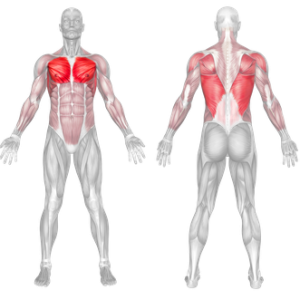Dumbbell Pullover Overview
A dumbbell pullover is a strength training exercise that targets the muscles of the upper body, including the chest, back and shoulders. It involves lying down on a flat or slightly inclined bench and holding a dumbbell with both hands above your chest.
How To do:
Here are the steps to perform a dumbbell pullover exercise:
- Position your upper back on the bench. Your feet should be flat on the floor, and your knees bent at a 90-degree angle.
- Hold a dumbbell with both hands, with your palms facing upward and your arms extended over your chest.
- Slowly lower the dumbbell back behind your head while keeping your arms straight and your core engaged. You should feel a stretch in your chest and lats as you lower the weight.
- Pause for a second when the weight is just above your head, then slowly raise the weight back up to the starting position. Make sure to keep your arms straight and avoid bending your elbows.
- Repeat for the desired number of repetitions.
It’s important to maintain good form throughout the exercise to avoid injury and get the most out of the movement. If you want to target the chest, then you will need to keep your arms as straight as possible, and your elbows in tight.
Coach Tips
- Start with a lighter weight to master the movement and avoid strain.
- Keep your core tight to prevent your lower back from arching.
- Avoid lowering the dumbbell too far if it causes discomfort in your shoulders.
Dumbbell Pullover Benefits

1- Targets Multiple Muscles:
Dumbbell pullover is one of the rare exercises that trains both the front and back of the body at the same time. The main purpose of this exercise is to work the chest and back muscles, in order to strengthen them, and help you gain muscle mass. By engaging multiple muscle groups at once, you can increase your overall strength and muscle mass.
2- Increases Chest Size:
The dumbbell pullover is a great exercise for building a bigger chest. By stretching the chest muscles during the movement, you can activate more muscle fibers and stimulate muscle growth. (Learn how to do a chest workout for mass)
3- Better Posture and Mobility:
Dumbbell pullover is considered a postural exercise by sports physiologists and researchers. The dumbbell pullover can also help to improve shoulder mobility by stretching the chest and lats. This can help to improve your posture and reduce the risk of shoulder injuries.
Dumbbell Pullover Muscles Worked

Incorporating Dumbbell Pullovers into Your Workout Routine
Here are some tips on how to incorporate this exercise into your workout routine:
- Warm-Up First: Before performing dumbbell pullovers, ensure your body is warmed up to reduce the risk of injury. Focus on dynamic stretches or light exercises targeting your chest, shoulders, and back, such as arm swings, push-ups, or resistance band pull-aparts.
- Choose the right weight: Start with a weight that you can handle comfortably, but that still challenges you. You want to aim for 8-12 repetitions with good form.
- Choose your position: Dumbbell pullovers can be done on a bench or stability ball. Choose the position that you feel most comfortable with.
- Focus on form: Keep your core engaged and maintain good posture throughout the exercise. Slowly lower the weight behind your head until you feel a stretch in your chest and lats, then pull the weight back up over your chest.
- Increase weight over time: As you get stronger, gradually increase the weight you use for dumbbell pullovers. Remember to always focus on good form.
- Combine with other exercises: Dumbbell pullovers can be combined with other exercises to create a full-body workout. For example, you can perform dumbbell pullovers followed by push-ups or pull-ups.
- Use different variations: You can vary the dumbbell pullover by changing the angle of the bench, or by using a single dumbbell or barbell.
- Incorporate into a superset: You can pair dumbbell pullovers with other exercises in a superset. For example, you can perform dumbbell pullovers followed by dumbbell flyes.
- Don’t forget to cool down: After completing your workout, take some time to stretch and cool down your muscles. This can help prevent soreness and injury.
Repetition and Load
- For hypertrophy: Use a heavier dumbbell for 8–12 reps per set.
- Muscle Endurance: Opt for a lighter weight and perform 12–15 reps per set.
- Flexibility and Mobility: Use very light weight and focus on slow, controlled movement for 10–12 reps.
Aim for 3–4 sets depending on your goals and fitness level.
Refferance:https://scholarworks.csun.edu/handle/10211.3/204926


